
Mark Gertler, Merry-Go-Round 1916. Tate.
Modern Times 1910–1920
17 rooms in Historic and Early Modern British Art
In the years leading up to war, a new generation of British experimental artists emerges who challenge traditional artistic practices
Tense international politics lead to the outbreak of the First World War in 1914. Millions of people in Britain and British colonies around the world volunteer or are drafted into the army. This ‘war to end all wars’ results in death and destruction on an unprecedented scale. Meanwhile, events such as the Easter Rising in Ireland in 1916 and the Amritsar Massacre in India in 1919 strengthen calls for independence from British rule.
During this period, growing cultural internationalism between European cities inspires artists to experiment and make new connections. British artists form small groups that exhibit outside the traditional exhibition spaces like the Royal Academy. This includes the New English Art Club, which shows the work of young British artists who return from studying in Paris with new ideas and influences. The intense colours and simplified forms used by French and Italian artists inspire the Bloomsbury and Camden Town Groups. The Camden Town Group focuses on painting scenes of everyday life in the changing 20th-century city. The Bloomsbury Group includes artists, writers, and philosophers. They want the freedom to develop modern ideas, adopting liberal attitudes to relationships in their art and lifestyles.
Vorticist and Futurist artists express the dynamic energy of the newly industrialised world through machine aesthetics, jagged abstract forms and repeated motifs conveying movement. Many modern artists also take inspiration from the sculptures they see in museum displays of cultural objects, such as those taken from Africa, Asia, and Oceania. The way these forms represent the body transforms European art at this time, while the countries from which they originated continue to struggle under European colonial power.

Mark Gertler, Merry-Go-Round 1916
This work was painted at the height of the First World War, which seems to be its subject. Men and women in rigid poses, their mouths crying in silent unison, seem trapped on a carousel that revolves endlessly. Gertler was a conscientious objector. He lived near London’s Hampstead Heath, and may have been inspired by an annual fair held there for wounded soldiers. The fairground ride, traditionally associated with pleasure and entertainment, is horrifically transformed into a metaphor for the relentless military machine. He explained, ‘Lately the whole horror of war has come freshly upon me’.
Gallery label, September 2016
1/28
artworks in Modern Times

Duncan Grant, Head of Eve 1913
Grant liked to fuse many different stylistic influences in his work, and he was particularly interested in the invigorating example of non-Western art forms. The mask-like face and symmetrical pose of Head of Eve suggests a sensual Eden by drawing on Byzantine mosaics as well as the wooden masks of the African Fang tribe. There is also a more contemporary stylistic debt to Picasso. The simplified form and intense colour lend a sense of commanding immediacy.
Gallery label, February 2010
2/28
artworks in Modern Times
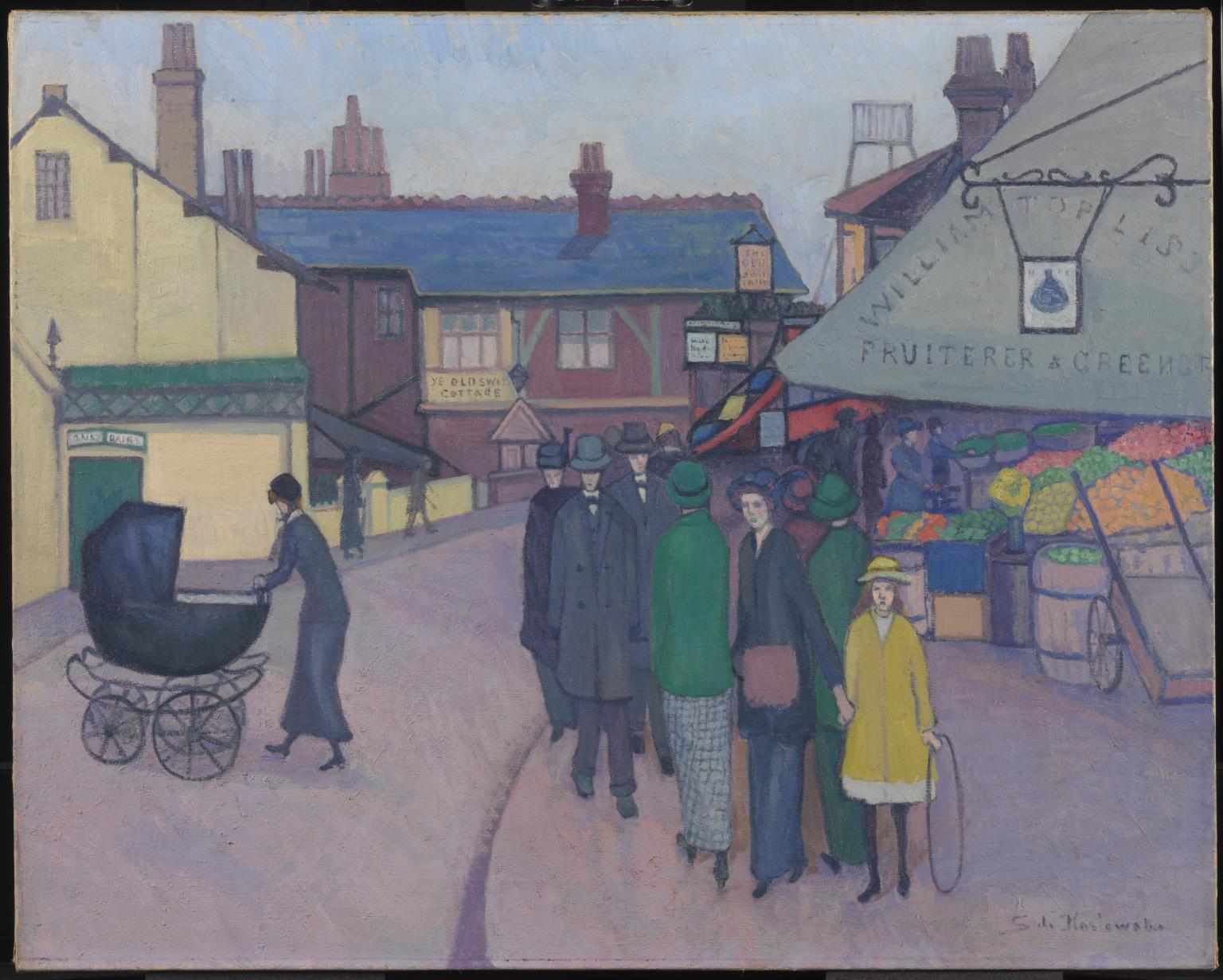
Stanislawa De Karlowska, Swiss Cottage exhibited 1914
Although De Karlowska’s husband Robert Bevan was a founder-member of the Camden Town Group, as a woman, De Karlowska was excluded. She exhibited instead in the more liberal areas of London's contemporary art scene such as the Allied Artists Exhibitions, where this painting was shown in 1914. As in Fried Fish Shop, also on show here, in Swiss Cottage De Karlowska addresses the question that was absorbing many artists - how to depict the modern city. Departing radically from artistic tradition, she uses non-naturalistic colour and the deliberate naivety of primitivism, the deliberate naivety drawn from ‘primitive art’ that fascinated early twentieth-century artists.
Gallery label, February 2010
3/28
artworks in Modern Times

Walter Richard Sickert, Brighton Pierrots 1915
Sickert painted this work during the early part of the First World War, and it has a pervasive atmosphere of strangeness and melancholy. A party of vaudeville entertainers perform on the Brighton seafront under the setting sun and artificial stage lights. Many of the deckchairs are empty, perhaps hinting at the absence of so many men in the war; the gunfire of the Western Front could sometimes be heard along the south coast of England. Against that and the deep pink of the sky, the performers seem a bit ridiculous, if not pathetic.
Gallery label, September 2016
4/28
artworks in Modern Times

Mark Gertler, The Artist’s Brother Harry Holding an Apple 1913
This painting depicts Mark Gertler’s elder brother Harry in a head and shoulders format, holding an apple in his right hand. The sitter’s body is turned to the left and his right shoulder is raised while his head is shown full-face and his eyes directly engage the viewer. He holds the apple lightly between his thumb and third finger as if showing it to the viewer or offering it to an unseen companion outside the picture plane. The work is painted in vibrant contrasting colours; the light blue of the background and deep blue of the sitter’s clothing contrast with the deep red of his lips and the warm orange and red tones of the apple. The work was begun in tempera on panel and completed in oil paint. Gertler’s interest in tempera as a medium was shared by other artists in the early twentieth century who were interested in both the techniques and the formal simplifications of early Italian painters of the fourteenth century such as Giotto, then described as the ‘Italian primitives’; between 1910 and 1912 Gertler was a member of the short-lived group the ‘Neo-primitives’, together with fellow Slade students C.R.W. Nevinson, Edward Wadsworth, Adrian Allison and John Currie. These early Italian influences are also seen in the plain blue background of The Artist’s Brother Harry Holding an Apple. Gertler experimented with tempera and ‘neo-primitive’ composition and colour in other portraits of this period, such as Portrait of a Girl Wearing a Blue Jersey 1912 (formerly Edgar Astaire Collection). Interviewed in the Jewish Chronicle in 1912, Gertler expressed his admiration for the work of Piero della Francesca and Giovanni Bellini and stated that, ‘One should never forget the primary function of art – the music and rhythm of colour. Characterisation and psychology, all important in the novel, are quite of secondary importance in the picture’ (quoted in ‘A Triumph of Education Aid’, Jewish Chronicle, 9 February 1912, p.22). In this portrait of his brother, the sitter’s deliberately theatrical, non-naturalistic pose and the vibrant opposing colours in the work both reflect these ideas.
5/28
artworks in Modern Times

Sir Matthew Smith, Nude, Fitzroy Street, No. 1 1916
This is among the most advanced in style of Smith's paintings. It is one of a pair showing a model in the same pose from two different points of view, painted in his studio in Fitzroy Street. 'Nude No.2', which belongs to the British Council, shows the model seen from the front, and has slightly more detail in the background. Soon after these were painted Smith, who had already joined the Artists' Rifles, was called to France with the army. After the war he painted little until his stay in Cornwall in 1920.
Gallery label, September 2004
6/28
artworks in Modern Times

Walter Richard Sickert, The New Bedford c.1914–15
In his youth Sickert had acted on the stage and he often depicted London music halls and their audiences. This theatre in Camden Town, near Sickert’s home in Mornington Crescent, was destroyed by fire in 1896 and subsequently rebuilt as the ‘New Bedford’. Sickert emphasises the splendour and the towering perspective of the grand Edwardian architecture which dwarfs the audience.
By the 1860s there were over 200 small music halls in London which catered mainly for working class audiences. Sickert was one of the first artists who attempted to record their distinctive atmosphere.
Gallery label, September 2004
7/28
artworks in Modern Times
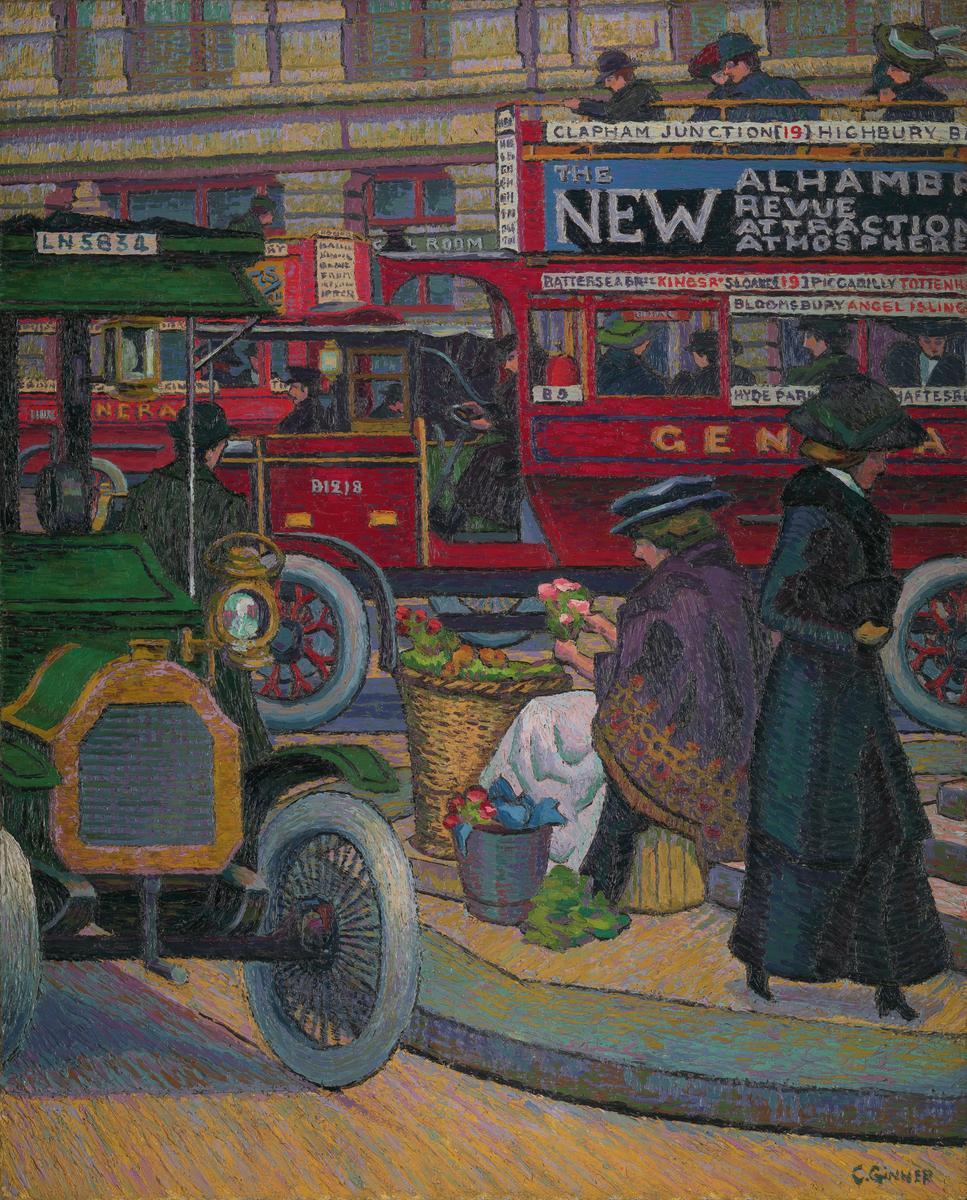
Charles Ginner, Piccadilly Circus 1912
Piccadilly Circus was London’s busiest intersection and by 1910 was already dominated by its famous illuminated advertisements. Here Ginner captures the brashness and bustle of this epitome of the modern city. The feeling that the flower seller is imprisoned by motor cars and buses is emphasised by the low view point of the composition, while the passing bus advertises the latest music hall show.
Gallery label, July 2007
8/28
artworks in Modern Times

Jessica Dismorr, Abstract Composition c.1915
Dismorr’s writings and art reflect her interest in the city and its architectural forms. Here, the simplified elements suggest arches, piers and girders, suspended in a darkened, undefined space. The sense of depth sets her style apart from the flatter compositions of other vorticist artists. Vorticism was unusual for an early twentieth-century avant-garde group, in that it included female artists among its core members. Dismorr and Helen Saunders both showed work at the group’s exhibitions. They also contributed to its journal, Blast, which supported the Suffragette movement for women’s rights.
Gallery label, October 2020
9/28
artworks in Modern Times

Sir Jacob Epstein, Torso in Metal from ‘The Rock Drill’ 1913–15
Writing in 1940, Epstein described this sculpture as ‘a machine-like robot, visored, menacing’. He originally set a plaster figure on top of a real industrial rock drill as a symbol of the machine age. Epstein’s attitude to machines changed as the mechanised warfare of the First World War caused vast numbers of casualties. After it was first exhibited in 1915, he removed the drill and cut the figure down at the waist. The left hand and right arm were taken off. It was then cast in bronze. The once-threatening figure appears vulnerable, more a victim than a perpetrator of violence.
Gallery label, October 2020
10/28
artworks in Modern Times

David Bomberg, In the Hold c.1913–14
The subject of this painting is the hold of a ship, in which dock workers are handling heavy freight. However, Bomberg has divided the canvas into a grid of squares that are themselves divided. The effect of this is to shatter form, transforming the scene into a kinetic pattern of shape and dazzling colour. Though the image has become hard to decipher, the fragmented composition expresses the energy of men at work in an industrial environment.
Gallery label, October 2020
11/28
artworks in Modern Times

Henri Matisse, Standing Nude 1907
The simplified, angular planes and exaggerated features of this nude suggest the influence of carved figures. Matisse's interest in African art began around 1906, and is probably reflected in this painting. Based on a photograph rather than a model, it subverts the tradition of the academic studio nude. The austere colours are a departure from the brightness of Matisse's earlier Fauvist period.
Gallery label, September 2004
12/28
artworks in Modern Times
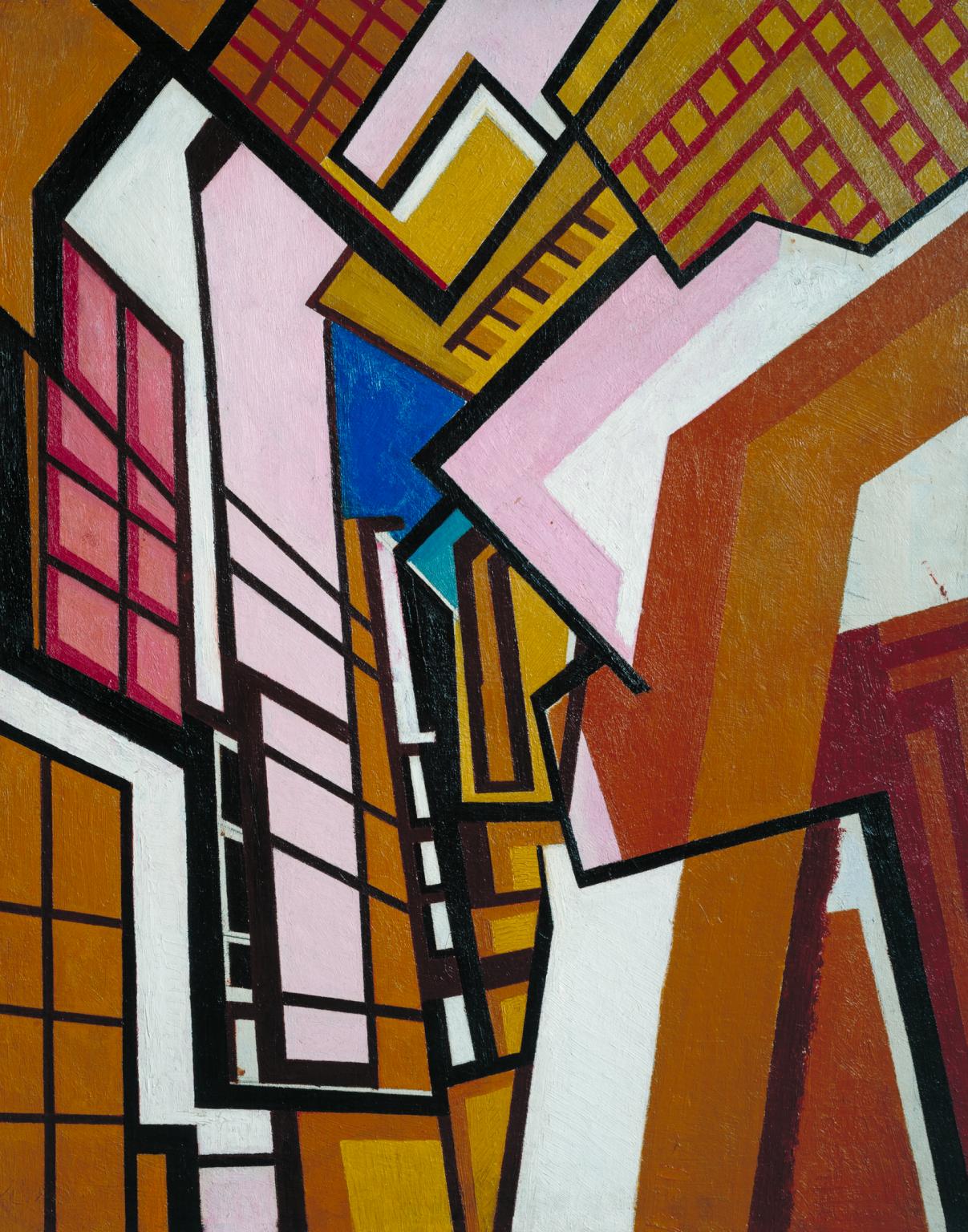
Wyndham Lewis, Workshop c.1914–15
Vorticism was a short-lived but radical movement founded by Lewis in London just before the First World War, proposing an art suited to the energy of the modern world. Here, Lewis uses angles and diagonals to suggest the geometry of modern buildings. Its harsh colours and lines echo the discordant vitality of the modern city in an ‘attack on traditional harmony’. The vorticists’ aggressive rhetoric, angular style and focus on modernity linked them to the Italian futurists. War demonstrated the devastating reality of pitting men against machines and Lewis’s attempts to revive the movement in 1919 came to nothing.
Gallery label, September 2016
13/28
artworks in Modern Times

Christopher Richard Wynne Nevinson, Bursting Shell 1915
One of the most apocalyptic of Nevinson's paintings, Bursting Shell uses the strong lines and swirling movement of Futurist and Vorticist compositions to recreate the effect of an explosion. The dark shapes, which could be shards of debris or shadows, fracture what appear to be the bricks and timber of buildings and roads. The strong focal point of the vortex - with its bright light and dizzying spiral - simulates the disorientating sensory experience of an explosion.
Gallery label, August 2004
14/28
artworks in Modern Times

Sir William Orpen, Zonnebeke 1918
Orpen was an official war artist for the British Army during the First World War. His pictures from this time feature injured and dead soldiers in blasted battlefields. He tries to bring the viewer closer to the physical and emotional experience of war. Zonnebeke, in Belgium, was the scene of the Battle of Passchendaele in 1917. This saw hundreds of thousands of soldiers killed on both sides of the conflict. Here, Orpen presents an eerily silent and stylised vision of the brutalities of war.
Gallery label, November 2019
15/28
artworks in Modern Times

Bruce Turner, Pavlova c.1912
This painting depicts the ballerina Anna Pavlova who performed three times in Leeds, Turner’s home city, in 1912. Pavlova’s performance was described at the time as ‘the event of the century’. Turner painted the work in the same year as an important exhibition in London of Italian futurist art, which received considerable press attention. Here he explores a fundamental futurist concern, the description of a figure in motion. Showing similarities to the work of Italian futurist Gino Severini, the fragmented and multiplied figure of the dancer gives a vivid sense of her passage through space.
Gallery label, September 2016
16/28
artworks in Modern Times

Augustus John OM, Portrait of a Woman 1911
Augustus John was one of the star pupils of the Slade School in the late 1890s. He was invited to exhibit with the New English Art Club, and was one of its most innovative contributors in the early years of this century.This portrait of the artist's wife Dorelia, was made for the important American collector John Quinn, who was an early admirer of John's work. The technique of painting in oils with pure colour, unshaded, had first been used by John in sketches of Provence in 1910. He used the same style in this portrait, but with quieter colours.
Gallery label, September 2004
17/28
artworks in Modern Times
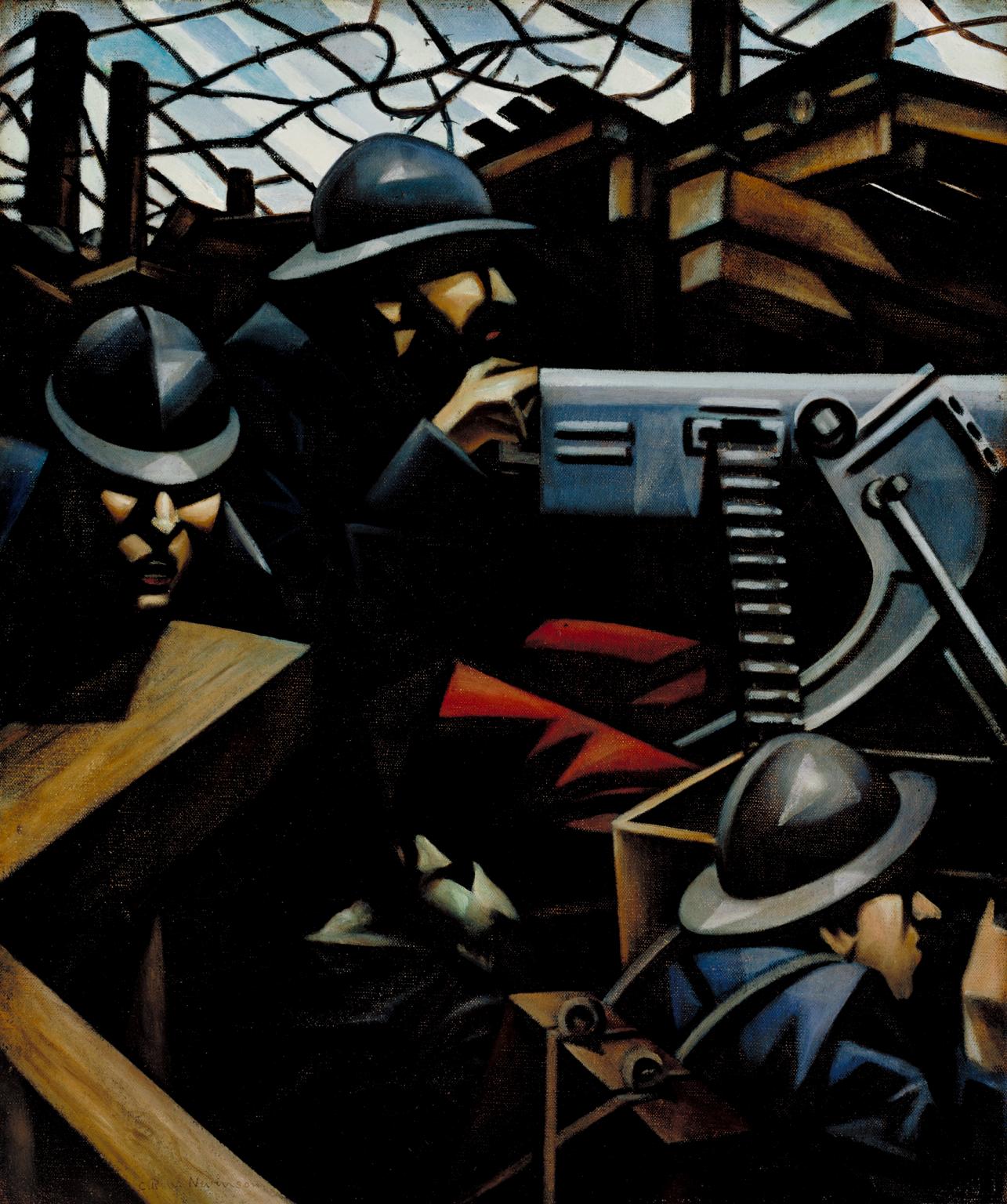
Christopher Richard Wynne Nevinson, La Mitrailleuse 1915
Nevinson aligned himself with the Italian futurists who celebrated and embraced the violence and mechanised speed of the modern age. But his experience as an ambulance driver in the First World War changed his view. In his paintings of the Front, the soldiers are reduced to a series of angular planes and grey colouring. Here, they appear almost like machines themselves, losing their individuality, even their humanity, as they seem to fuse with the machine gun which gives this painting its title.
Gallery label, September 2016
18/28
artworks in Modern Times
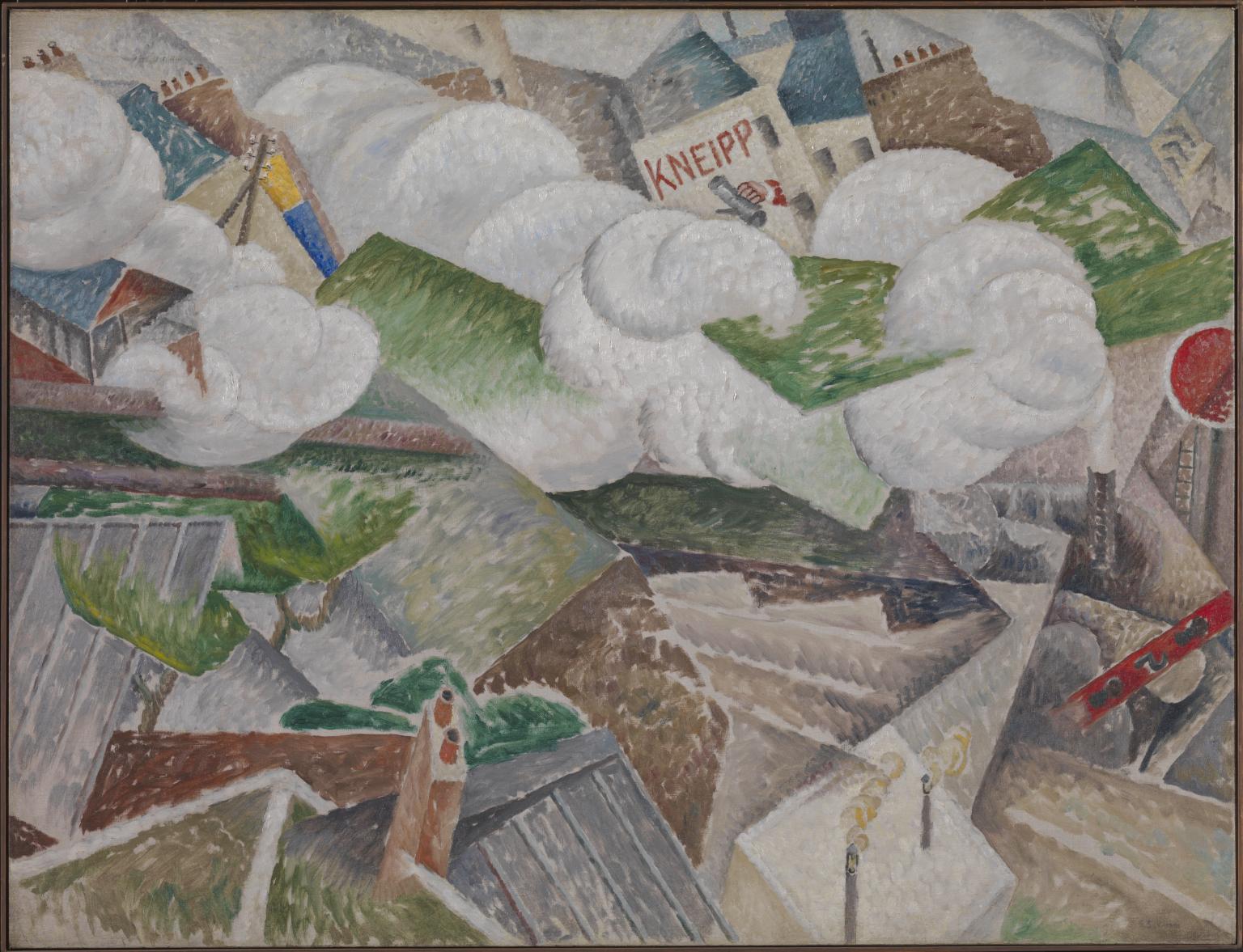
Gino Severini, Suburban Train Arriving in Paris 1915
This painting of a train arriving in Paris attempts to express movement and conflicting energies through its fractured, interpenetrating forms. Like all the Italian futurists, Severini was inspired by modern machinery and was enthusiastic about the idea of war. In June 1915 he stayed for some weeks just outside Paris where the sight of trains passing close by day and night laden with munitions, soldiers or wounded prompted the creation of this work.
Gallery label, February 2016
19/28
artworks in Modern Times

Vanessa Bell, Studland Beach. Verso: Group of Male Nudes by Duncan Grant c.1912
Studland Beach is in a quiet bay in Dorset. The idea of the beach as a place for leisure activities was relatively new in 1912. It is a sign of their modernity that Vanessa Bell and her Bloomsbury Group friends holidayed there. This is one of several works by Bell from 1911–2 which show a debt to Matisse in their simplified design and bold colouring. Though an exercise in what her friends, the critics Clive Bell and Roger Fry, called ‘significant form’ (emphasising colour, shape and line rather than subject matter), the picture retains some of the feel of a sunny day by the sea.
Gallery label, September 2016
20/28
artworks in Modern Times

Sir Stanley Spencer, Apple Gatherers 1912–13
The subject of this painting was given to Spencer by his teachers at the Slade School of Art. The scene was suggested by a spot on Odney Common, in his native village of Cookham.
Spencer wrote of the painting: ‘There is no symbolic meaning whatsoever intended in Apple Gatherers and I cannot account for the fact I have divided the sexes.’ The distortions of form and scale show Spencer’s interest in paintings he had seen in London by the French Post-Impressionist artist, Paul Gauguin.
Gallery label, September 2004
21/28
artworks in Modern Times

Sir Jacob Epstein, Doves 1914–15
Jacob Epstein moved to England from America in 1905. The sculpture of Epstein and his contemporaries represented a new direction in British sculpture. They used ‘direct carving’, a method of cutting directly into wood or stone, choosing not to create preparatory wax or clay models as had been traditional. Epstein collected African and Oceanic sculpture, which influenced the bold simplified forms of his work. Doves represents two copulating birds and reflects Epstein’s interest in exploring sexuality and procreation and his wish to find subjects that were expressive but not complicated.
Gallery label, March 2018
22/28
artworks in Modern Times

William Ratcliffe, Hampstead Garden Suburb from Willifield Way c.1914
The construction of public railways led to the growth of the suburbs as it became possible to commute from further afield. Ratcliffe lived in Hampstead Garden Suburb, a new development built in 1907 between Golders Green and East Finchley. It was devised by the philanthropist Mrs Henrietta Barnett, who bought a large amount of land and built residential areas for artisans, the middle classes and the more affluent. This view is from a tower that is part of the Hampstead Garden.
Gallery label, February 2004
23/28
artworks in Modern Times

Spencer Gore, The Cinder Path 1912
In the summer of 1912 Gore went to stay in the new town of Letchworth. Here he painted some of the more avant-garde
landscapes
of his career, using stylised forms and vivid colours.
The Cinder Path shows a place on the outskirts of Letchworth. Gore’s perspective
means that the path, which is made of industrial waste, recedes vertically into the middle-distance, and the fields and hedges are arranged around it. This was one of the few British pictures exhibited in the influential Second Post-Impressionist
Exhibition organised by Roger Fry in the winter of 1912.
Gallery label, May 2011
24/28
artworks in Modern Times

Spencer Gore, Rule Britannia 1910
This painting shows the finale of a popular patriotic ballet called Our Flag, which opened at the Alhambra Theatre of Varieties, Leicester Square, in December 1909. It starred the Danish ballerina Britta Petersen, shown here performing the final dance in her Union Jack tutu. Gore emphasises the unusual colours of the stage lighting, which contrast with the dullness of the auditorium. Gore was fascinated by the theatre, ballet and music hall. Many of his paintings are based on drawings he made from his seat in the audience.
Gallery label, October 2020
25/28
artworks in Modern Times

Christopher Richard Wynne Nevinson, The Arrival c.1913
When this work was first exhibited a reviewer commented: ‘It resembles a Channel steamer after a violent collision with a pier. You detect funnels, smoke, gangplanks, distant hotels, numbers, posters all thrown into the melting-pot, so to speak. Mr. Nevinson acted as interpreter, explaining that it represented a state of simultaneous mind.’ Nevinson co-wrote Vital English Art: A Futurist Manifesto. He was fascinated by the idea of ‘simultaneity’. This is shown here in his attempt to capture in one composition the many views and movements in a single moment.
Gallery label, September 2016
26/28
artworks in Modern Times

Duncan Grant, Bathing 1911
This was painted in the summer of 1911 as part of a decorative scheme for the dining room at the Borough Polytechnic, London. The theme was ‘London on Holiday’, and Grant responded by painting this idealised panorama of seven male nudes bathing. The nudes also represented the continuous movement of a single figure. Grant’s design was inspired by Michelangelo’s male nudes and summers spent at the Serpentine in Hyde Park, which was a site associated with London’s gay culture. Bathing was seen as controversial at the time it was painted, due to its homoerotic implications.
Gallery label, August 2019
27/28
artworks in Modern Times

J.D. Fergusson, Blue Beads, Paris 1910
This painting is one of many studies Fergusson made of a type of European female beauty, seen as modern at the time. The sitter is not known and the work’s title draws attention to its decorative intention. This is enhanced by the heavy, rhythmic outline and expressive, bold colour. Fergusson was one of the most significant Scottish artists of the early 20th century. He was a leading figure among the ‘Scottish Colourists’ who adopted the bright colours and simplified outlines of modern French painting. Fergusson visited Paris frequently and lived there from 1907 to 1914.
Gallery label, October 2020
28/28
artworks in Modern Times
Art in this room




























You've viewed 6/28 artworks
You've viewed 28/28 artworks